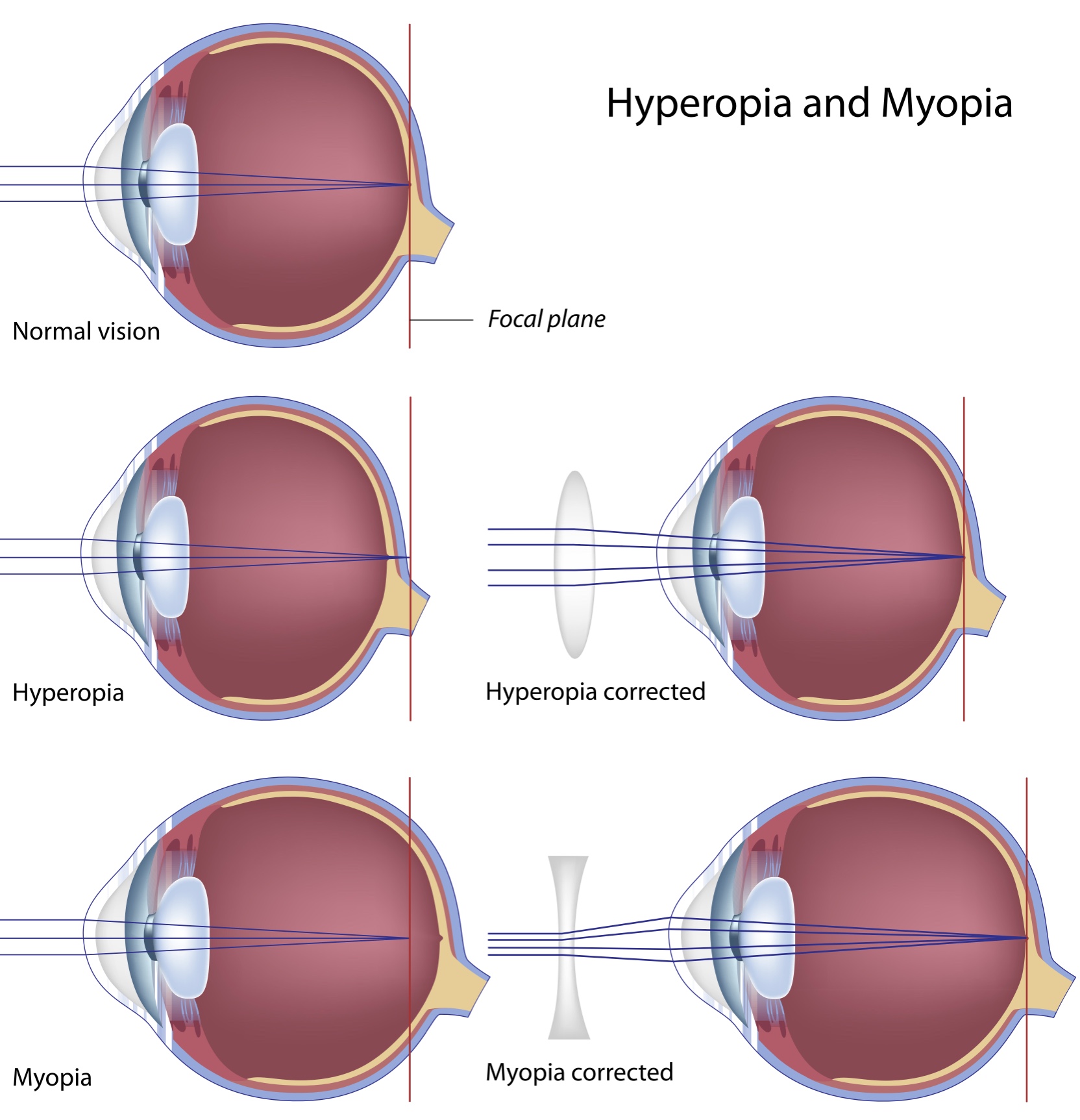Reducing the Need for Glasses and Contact Lenses
Why do I need to wear glasses or contact lenses?
There are a number of conditions which can make our vision blurred that are corrected by wearing glasses or contact lenses. Depending on the type of condition, you may have trouble seeing objects at a distance from you, close to you, or both. The conditions that cause these problems are:
- Myopia (Short sightedness)
- Hyperopia (Long sightedness)
- Astigmatism
- Presbyopia
Myopia
Myopia is one of the common conditions that causes people to have trouble seeing objects in the distance but have no problems seeing objects close to them. It is also called short sightedness. Activities that many people with myopia find difficult without wearing glasses or contact lenses are driving a car, watching TV or playing sports.
Myopia is caused by the eyeball growing too long or in some cases, the curvature of the cornea (the clear dome at the front of the eye) being too steep.
Hyperopia
Hyperopia is another common eye condition which causes people to have difficulty focusing on objects close to them but have less of a problem seeing things far away. This condition is also known as long sightedness. As people with hyperopia become older, they often also have increased difficulty seeing objects at a distance as well as up close. This causes people to need glasses or contact lenses for both reading as well as seeing things at a distance from them.
Hyperopia is caused by the eyeball being too short or in some cases, the curvature of the cornea (the clear dome at the front of the eye) being too flat.
Astigmatism
Astigmatism is a condition where objects at both distance and near appear blurred. It is caused by the cornea (the clear dome at the front of the eye) not being a perfect spherical shape. An eye without any astigmatism has a cornea that is shaped like half a soccer ball. An eye with astigmatism is shaped more like half a rugby or AFL ball. When the cornea is not spherical, the light entering the eye is not focussed precisely and results in vision being blurred at all distances. When astigmatism is mild however, people generally only notice that the distance vision is blurred.
Presbyopia
Presbyopia is a result of changes that happen within our eye as we age. When we are younger, the lens within our eye is flexible. This allows it to change its shape which is how we are able to change our focus from something in the distance to something close to us. As we age, the lens becomes less flexible and as a result, things closer to us become harder to bring into focus.
The first signs of presbyopia are needing to move a book, magazine or computer tablet further away from you to make it appear clear. Often people will make the comment ‘my arms aren’t long enough anymore’ when presbyopia is starting to affect their close vision more significantly.
Treatment Options
For all of the conditions mentioned above, the use of glasses or contact lenses will almost always provide clear vision. For people who would like to reduce or eliminate their need for glasses and contact lenses, there are now many options available. The most appropriate option depends on many factors including the type of condition, the health of the eye, the shape and thickness of the cornea and the age of the patient. A consultation with one of our experienced Ophthalmologists will allow the best option to be selected with you.
Refractive eye surgery options are laser eye surgery, Refractive Lens Exchange (RLE) or Supplementary intraocular lens (ICL) insertion.
Laser Refractive Surgery (ASLA)
Uses an excimer laser to reshape the cornea. ASLA/PRK (Advanced Surface Laser Ablation Surgery) lasers directly onto the collagen surface of the cornea.
Refractive Lens Exchange (RLE)
Involves removing the lens from inside the eye and replacing it with an artificial lens which is customized to the shape and length of the eye. Intraocular lens options include distance or multifocal options.
Supplementary Intraocular Lens Insertion
The Implantable Collamer Lens (ICL) is an advanced, thin, clear lens that functions similarly to a contact lens, however it is surgically implanted into the eye. The ICL cannot be felt while in the eye, requires no maintenance and can be removed if needed. The ICL does not replace your natural lens, but is implanted in front of your natural lens and behind your iris (the coloured part of the eye).
Which treatment is most suited to you?
The following table is a guide to which treatment option might be best, but your doctor will assess the best and safest treatment for you. This will be determined by the nature of your eye and your visual needs.
| ASLA | RLE | ICL | |
|---|---|---|---|
| Visual quality | High | High | High |
| Recovery | Up to 4 weeks | 1-2 weeks | 1-2 weeks |
| Dry eye | Yes, during recovery | No | No |
| Patient satisfaction | Excellent | Excellent | Excellent |
| Reversible | No | No | No |
| Most suitable patient | Short-sighted, astigmatism | Short-sighted, long-sighted, presbyopia or astigmatism | Short-sighted, astigmatism, some long-sighted |
Comparative benefits of refractive surgery options:
Risks/Side-effects
- Refractive inaccuracy/ treatment failure
- Bruising
- Dry or irritated eyes
- Fluctuating vision.
- Sub-conjunctival haemorrhage.
- Visibility of the treatment zone perimeter (ASLA)
- Anisometropia, and impaired binocular vision
- Presbyopic symptoms (difficulty reading)
- Night vision blur, haloes, flare
Major complication
While it is very uncommon with these techniques there is a very small chance of a loss of vision.


